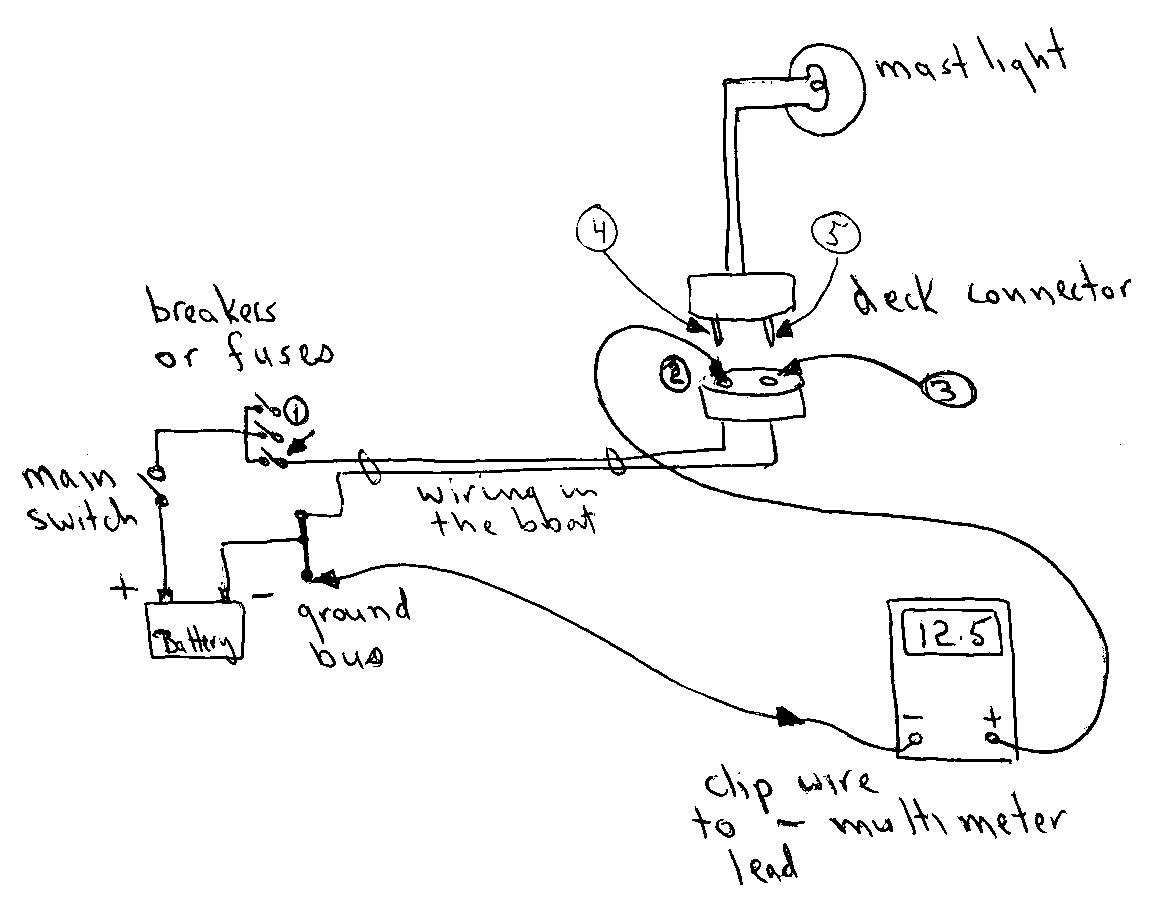Tecktalk - Marine Electrical Systems (part 2)
April 2000 Telltale page 3 - by Tom Winlow and Marcel Laroche.
Continuing on from last month where we looked at batteries, this article will provide a few basic ideas about how to find electrical faults in the boats wiring systems.
Trouble Shooting lights and other stuff
There are two basic fault classes: short circuits and open circuits. Shorts are easier to find because they are often accompanied by smoke. Well if not smoke then at least the fuse or breaker blows. If you suspect a short because the fuse or breaker keeps blowing, then switch of the batteries, open all breakers, and remove the bulb or disconnect the wires from the instrument. Measure the resistance in Ohms using the multi-meter between the plus side of the circuit and the ground. You should see near 0 Ohms. The next step is finding where the wire is touching a ground point. Look for where it goes through metal holes or bends sharply around engine bits where it could vibrate. The insulation will likely be worn through. Another likely cause is that the wire has come loose from a connector and is touching a ground point. If it is worn through it should be replaced, and it should be secured so that it does not happen again. You can buy proper swage on connectors at the Chandlery as well as wire and connectors.
For open circuits, lets use a light as an example and assume it will not illuminate. Note also it is easier to check all this stuff up the mast when it is down and bulbs etc are accessible.
First check that the bulb is not burnt out. This is usually a visible inspection, but it is often a good idea to check with the multi-meter as well. Switch the meter to read Ohms and connect the meter leads, one to each contact on the bulb. If the bulb is OK the meter will typically read 1 or 2 Ohms. It is always a good idea to clean the contacts in the socket and the bulb when reinstalling it. This can be done with a bit of very fine emery paper or a hard pencil eraser. So the bulb is OK but will not light. Assuming the breaker is on or the fuse is OK then we have an open circuit somewhere in either the ground (negative) or the positive side of the circuit.
Finding open circuits requires peace of mind - to quote a Zen master. You will need your multi-meter and a long piece of insulated wire (lamp cord works well and is cheap) with alligator clips on both ends. (these things can be found at any Radio Shack for a few pennies) This will allow you to connect the multi-meter ground lead to the ground bus and then wander around the boat looking for the voltage. The diagram makes this a bit easier to understand.

So start with the breaker at point 1 and see if when the breaker is closed or ON, voltage appears on its load or lamp side. Check the battery to see what voltage to expect, for example 12.5. If not, the problem is in the breaker, but this is rarely the case. Most open circuits are at connectors, the bulbs themselves, or where the wiring has been joined.
Next connect the probe to the socket at point 2. You need to figure out whi ch is the ground and which are the connections for the various lights or other circuits. Locate the ground by connecting one lead to the ground bus, then going round each of the pins or sockets looking for 0 Ohms (switch off the batteries and open all breakers). Then by turning on each breaker one at a time you will see where the voltage appears and can mark on your drawing which circuit is which. This socket is then the one associated with the closed or "ON" breaker. If voltage is not here you likely have a bad connection to the socket, or worse, a broken wire. It is a good idea to disconnect the wires from the socket, clean them up and reconnect, especially if things are a bit green around the connectors. Green corrosion is a bad thing. If you see voltage at the socket, the problem is likely the socket or the mast wiring.
Reconnect the two meter leads to point 4 and point 5 and switch it to read ohms again, again make sure power is off. If the reading is very high thousands or more of Ohms then the bulb is likely shot or the wire is broken. If it reads something like tens or hundreds of Ohms, then a frayed wire or corroded connector is likely. All connections should be cleaned with emery paper and when working protected with a plastic spray. Sockets are hard to clean but I find using a bit of emery paper rolled up into a small tube and slid into the socket a few times helps. If the socket is really loose, should probably be replaced.
Wiring can also be checked using the Ohms range and connecting the meter to the ground bus and point 3 for example. Turn off the power. If the meter reads anything but 0 or a few milliohms ( thousandths) then you can suspect either corroded connectors or frayed and broken wire.
It is always a good idea to make a picture of what you are checking and jot down the wire colors as you go. It is easy to get mixed up and think you have checked something you have not. A diagram can avoid this. You will also appreciate a clean and tidy wiring job about now and if you are unfortunate enough to have a rats nest which proves impossible to trouble shoot, it might be time to think about rewiring.
Many of the new meters will have automatic protection against finger trouble like trying to measure voltage using the Ohms range. However if yours does not and you try it you will likely be shopping for a new meter. Make sure by always looking for volts first and do switch off the batteries when checking continuity using Ohms scales.
A final point about wiring. Do not usea wire size that is to small. The lamp or instrument or whatever will require a certain amount of current from the battery and wire that is too small can heat up, melt, and may in the worst case cause a fire. At best the instrument may not work properly. Understand what the power requirement is (it will be stated on the instructions or box) and ask the expert who supplies the wire what gauge should be used.
Hope this helps a bit in the annual struggle to get all the lights working and the tunes playing. Beer also helps.
